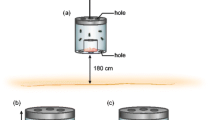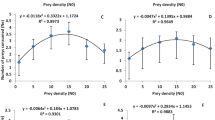Abstract
We analyzed the behavior of third-instars of Chrysomya putoria as potential cannibals in experimental populations. Cannibalism rates were evaluated in three settings observed for 3, 6, 9, and 24 h, placing injured and uninjured larvae of C. putoria together. Our data heavily support that C. putoria larvae behave as cannibals when induced by a wound in another larva, and also after starving for 24 h. The probability of cannibalism increased as a function of time, both in no-choice and in choice experiments evidencing that time is a determining factor for cannibalism induction in C. putoria. However, the treatment combining injured with uninjured larvae showed the highest probability of cannibalism. These results suggest that C. putoria larvae may cannibalize under scarcity of food over long time or the presence of injured larvae. This study is useful to understand the behavior of C. putoria feeding on ephemeral substrates such as carrion or corpses and brings relevant and significant contribution to population ecology of blowflies and also forensic entomology.

Similar content being viewed by others
References
Andow D, Farias JR, Horikoshi RJ, Bernardi D, Nascimento ARB, Omoto C (2015) Dynamics of cannibalism in equal-aged cohorts of Spodoptera frugiperda. Ecol Entomol 40:229–236
Cansi ER, Bonorino R (2011) Miíase por Lucilia eximia (Diptera: Calliphoridae) em Didelphis albiventris (Mammalia: Didelphidae) no Brasil Central. Entomol Bras 4:150–151
Charabidze D (2012) Necrophagous insects and forensic entomology. Ann Soc Entomol Fr 48:239–252
Crawley MJ (2009) The R book. John Wiley & Sons, Hoboken, 942p
De Jong G (1979) The influence of distribution of juveniles over patches of food on the dynamics of a population. Neth J Zool 29:33–51
De Jong G (1982) The influence of dispersal pattern on the evolution of fecundity. Neth J Zool 32:1–30
Elgar MA, Crespi BJ (1992) Ecology and evolution of cannibalism. In: Elgar MA, Crespi BJ (eds) Cannibalism, ecology and evolution among diverse taxa. Oxford Science, Oxford, pp 1–13
Faria LDB, Godoy WAC (2001) Prey choice by facultative predator larvae of Chrysomya albiceps (Diptera: Calliphoridae). Mem Inst Oswaldo Cruz 96:875–878
Faria LDB, Orsi L, Trinca LA, Godoy WAC (1999) Larval predation by Chrysomya albiceps on Cochliomyia macellaria, Chrysomya megacephala and Chrysomya putoria. Entomol Exp Appl 90:149–155
Faria LDB, Godoy WAC, Reis SF (2004a) Larval predation on different instars in blowfly populations. Braz Arch Biol Technol 47:887–894
Faria LDB, Trinca LA, Godoy WAC (2004b) Cannibalistic behavior and functional response in Chrysomya albiceps (Diptera: Calliphoridae ). J Ins Beh 17:251–261
Faria LDB, Reigada C, Trinca LA, Godoy WAC (2007) Foraging behaviour by an intraguild predator blowfly, Chrysomya albiceps (Diptera: Calliphoridae). J Ethol 25:287–294
Fincke OM (1994) Population regulation of a tropical damselfly in the larval stage by food limitation, cannibalism intraguild predation and habitat drying. Oecologia 100:118–127
Fox LR (1975) Cannibalism in natural populations. Annu Rev Ecol Syst 6:87–106
Godoy WAC, Von Zuben CJ, Ribeiro OB (1993) Population dynamics of Chrysomya putoria (Wied.) (Dipt., Calliphoridae). J App Entomol 116:163–169
Godoy WAC, Von Zuben FJ, Von Zuben CJ, Reis SF (2001) Spatio-temporal dynamics and transition from aymptotic equilibrium to bounded oscillations in Chrysomya albiceps (Diptera, Calliphoridae). Mem Inst Oswaldo Cruz 96:627–634
Grassberger M, Friedrich E, Reiter C (2003) The blowfly Chrysomya albiceps (Wiedemann) (Diptera: Calliphoridae) as a new forensic indicator in Central Europe. Int J Legal Med 117:75–81
Guimarães JH, Papavero N (1999) Myiasis in man and animals in the Neotropical Region. Editora Plêiade, São Paulo, p 308
Hansen MJ, Buhl J, Bazazi S, Simpson SJ, Sword GA (2011) Cannibalism in the lifeboat—collective movement in Australian plague locusts. Behav Ecol Sociobiol 65:1715–1720
Hulley PE (1983) A survey of the flies breeding in poultry manure, and their potential enemies. J Entomol Soc South Afr 46:37–47
Laurence BR (1988) The tropical African latrine blowfly, Chrysomya putoria (Wiedemann). Med Vet Entomol 2:285–291
Leal TTS, Prado AP, Antunes AJ (1982) Rearing the larvae of the blowfly Chrysomya chloropyga (Wiedemann) (Diptera, Calliphoridae) on oligidic diets. Revta Bras Zool 1:41–44
Linhares AX (1988) The gonotrophic cycle of Chrysomya megacephala (Diptera, Calliphoridae) in the laboratory. Revta Bras Entomol 32:383–392
Madeira NG, Silveira GAR, Pavan C (1989) The occurrence of primary myiasis in cats caused by Phaenicia eximia (Diptera: Calliphoridae). Mem Inst Oswaldo Cruz 84:341
Martins E, Neves JA, Moretti TC, Godoy WAC, Thyssen PJ (2010) Breeding of Ornidia obesa (Diptera: Syrphidae: Eristalinae) in pig carcasses in Brazil. J Med Entomol 47:690–694
Moretti TC, Thyssen PJ (2006) Miíase primária em coelho doméstico causada por Lucilia eximia (Diptera: Calliphoridae) no Brasil: relato de caso. Arq Bras Med Veter Zoot 58:28–30
Polis GA (1981) The evolution and dynamics of intraspecific predation. Ann Rev Ecol Syst 12:225–251
Reigada C, Araujo SBL, Aguiar MAM, Gião JZ, Guimarães PR Jr, Trinca LA, Godoy WAC (2013) Impacts of enemy-mediated effects and the additivity of interactions in an insect trophic system. Popul Ecol 55:11–26
Reis SF, Teixeira MA, Von Zuben FJ, Godoy WAC, Von Zuben CJ (1996) Theoretical dynamics of experimental populations of introduced and native blowflies (Diptera: Calliphoridae). J Med Entomol 33:537–544
Rosa GS, Carvalho LR, Godoy WAC (2004) Survival rate, body size and food abundance in pure and mixed blowfly cultures. Afr Entomol 12:97–105
Ryuda M, Nakayama H, Hayakawa YA (2008) Novel gene associated with intraspecific predation in Spodoptera litura larvae. Appl Entomol Zool 43:563–568
Simpson SJ, Sword GA, Lorch PD, Couzin ID (2006) Cannibal crickets on a forced march for protein and salt. Proc Natl Acad Sci U S A 103:4152–4156
Sonleitner FJ, Guthrie PJ (1991) Factors affecting oviposition rate in the flour beetle Tribolium castaneum and the origin of the population regulating mechanism. Res Popul Ecol 33:1–12
Tschinkel WR (1993) Resource allocation, brood production and cannibalism during colony founding in the fire ant, Solenopsis invicta. Behav Ecol Sociobiol 33:209–233
Ullyett GC (1950) Competition for food and allied phenomena in sheep-blowfly populations. Phil Trans R Soc Lond B 234:77–174
Vijendravarma RK, Narasimha S, Kawecki TJ (2013) Predatory cannibalism in Drosophila melanogaster larvae. Nat Commun 4:1789. doi:10.1038/ncomms2744
Acknowledgments
The authors are grateful to two anonymous reviewers for their constructive comments and Dr. Janet Reid for revising the text of the manuscript. VWB has been supported by a scholarship from FAPESP, FSF is supported by a scholarship from CAPES, and WACG is partially supported by a grant from CNPq and receives research support from FAPESP.
Author information
Authors and Affiliations
Corresponding author
Additional information
Edited by Patricia Thyssen – UNICAMP
Rights and permissions
About this article
Cite this article
Botteon, V.W., Fernandes, F.S. & Godoy, W.A.C. Induced Cannibalism in Experimental Populations of the Forensic Indicator Chrysomya putoria Wiedemann (Diptera: Calliphoridae). Neotrop Entomol 45, 217–220 (2016). https://doi.org/10.1007/s13744-015-0354-x
Received:
Accepted:
Published:
Issue Date:
DOI: https://doi.org/10.1007/s13744-015-0354-x




